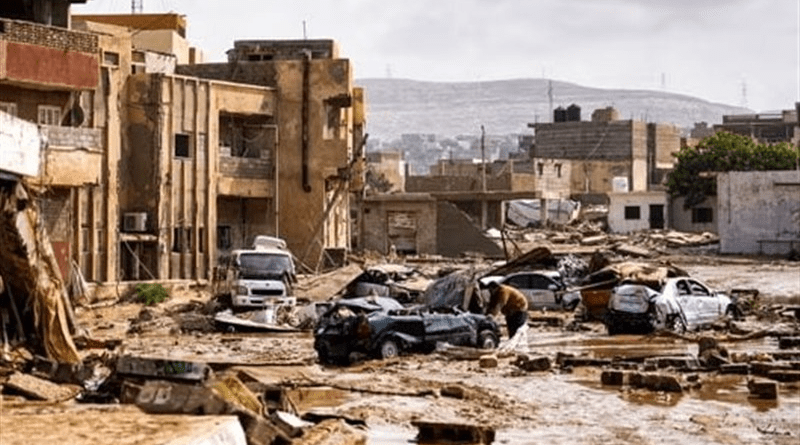Hurricane Daniel: The Failed Dams In Wadi Derna, Libya – OpEd
Due to Hurricane Daniel, the two dams surrounding the city of Derna in northern Libya collapsed, raising several questions about the reasons that resulted in this unprecedented disaster in the country.
Derna is a port city in eastern Libya with a population of around 90,000. The city is the administrative capital of Derna District, which has a unique location and physical environment as it lies between Jebel Akhdar (also known as Green Mountain), the Mediterranean Sea, and the desert. The city is also home to people of many different backgrounds.
In 2014, parts of the city were taken over by Islamic State (IS) militants, who controlled the eastern city of Derna and terrorized residents through summary executions. In June 2015, the Shura Council of Mujahideen in Derna defeated ISIS and took control of the town. However, they were eventually expelled by the Libyan National Army in the Battle of Derna (2018–2019).
The abuses are taking place in the absence of state authorities and the rule of law. Among the groups perpetrating these abuses are some that are affiliated with the extremist group Islamic State, which is destroying the country.
What were the two dams built for?
Historically, the city of Derna had been exposed to a series of floods in 1941, 1959, and 1968. The most severe flood occurred in 1959, prompting the Libyan government to take action. The government contracted with a Yugoslav company to build two dams in the 1970s. The upper dam was called the Al-Bilad Dam, with a storage capacity of 1.5 million cubic meters of water, and the lower dam, the Abu Mansour Dam, had a storage capacity of 22.5 million cubic meters. Both dams were built with a core of compressed clay surrounded by a shield of stone and rocks. The dams were successful in managing the water during a flood in 1986, preventing serious damage to the city.
After the civil war and the entry of armed groups, the maintenance of the two dams was neglected for a long time, and it appears that the structures of the two dams, which were built 50 years ago, were dilapidated. Also, there are no efficient drainage systems or protective infrastructure, making the surrounding areas more vulnerable to flooding.
Storm Daniel, the ‘medicane’, battered Greece before moving across the Sahara and developing into a storm in the Mediterranean with tropical cyclones. The warm Mediterranean water helped to strengthen Daniel as it approached Libya, bringing winds of 70–80 mph, according to Libya’s National Meteorological Centre. The devastation then came from the extreme rainfall, with 24-hour totals of 150–240 mm. These rains caused two dams to collapse, resulting in devastating flash flooding that has killed thousands of people.
International aid arrives as authorities open an investigation.
International aid is arriving in Libya from the UN, Europe, and Middle Eastern countries with an announced 29 metric tons. The World Health Organization said “the bodies of 3,958 people have been recovered and identified”, with 9,000 more still missing. While the Ministry of the Interior of Libya’s eastern government said a total of 5,300 people had been confirmed dead in the floods so far, aid groups and officials said that 10,000 people are missing, feared dead either beneath the wreckage of homes or lying somewhere in the floodwaters. The staggering statistics only go so far in conveying the tragedy.
Libyan authorities have opened an investigation into the collapse of two dams that caused a devastating flood. To investigate the collapse of the dams and the government’s allocation of maintenance funds, the city has disappeared and been submerged by waves. 7 meters (23 feet), many buildings have collapsed,
The call for the inquiry came separately to both governments of a country divided between rival eastern and western administrations: Mohamed al-Menfi, in the east as Libya’s presidential council chair, and Abdel Hamid Dabaiba, as the interim prime minister of the Tripoli-based government.
The government warned of the potential collapse of the Gazza Dam, located in the town of Bersis, northeastern Libya, in the Zaza Valley. It is situated 60 kilometers east of the city of Benghazi and about 10 kilometers south of the village of Al-Mubna, near the villages of Al-Hamda and Al-Militania. The valley extends for more than 100 kilometers, and the dam stands at a height of more than 200 feet. Damage to the water pumps caused by Storm Daniel has caused malfunctions.
The dam works to retain water, which helps provide agriculture in the area. The Wadi Zaza Basin covers 889 km2, with a water flow speed of 6.8 m3/hour. When the rains intensified, the dam’s water overflowed into residential areas, leading to the destruction of buildings.

